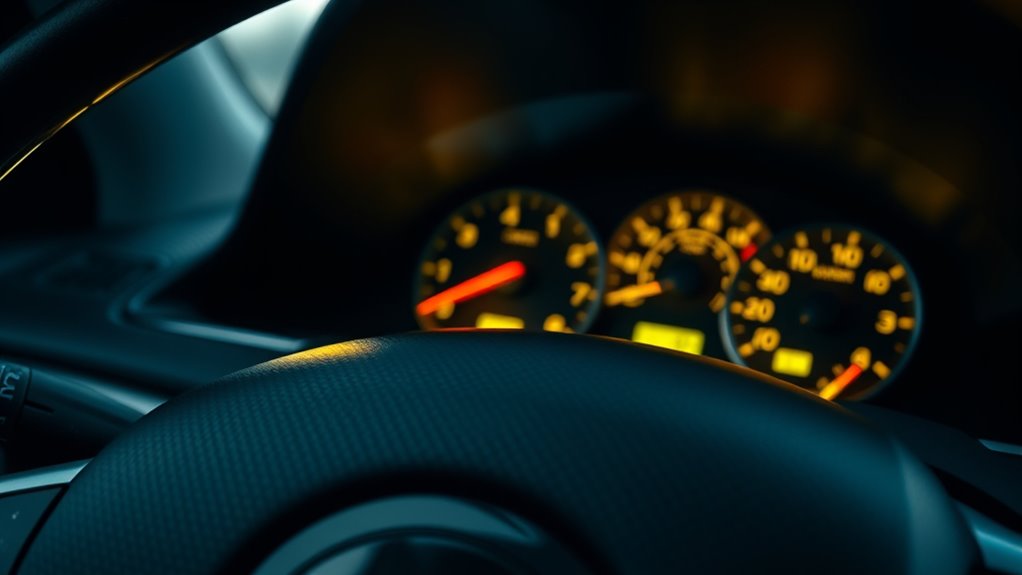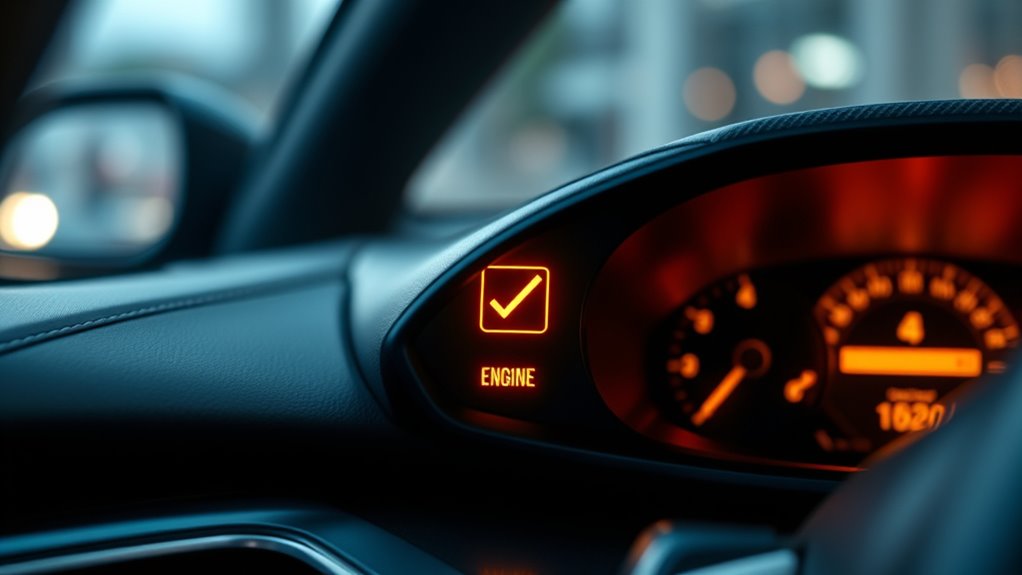When your “check engine” light comes on, stay calm and don’t panic. First, quickly check for simple issues like a loose gas cap. Use an OBD-II scanner to retrieve error codes, which tell you if the problem is minor or urgent. If codes point to complex issues, or if the light keeps flashing, it’s best to see a mechanic. Handling it promptly helps prevent costly repairs—learn more about what steps to take next.
Key Takeaways
- Remain calm and avoid panic to make clear, informed decisions.
- Use an OBD-II scanner to retrieve diagnostic trouble codes for accurate assessment.
- Interpret the error codes to determine if the issue is minor or requires professional repair.
- Perform basic maintenance like tightening the gas cap or inspecting hoses to resolve simple problems.
- Seek professional help promptly if diagnostic codes indicate complex or serious engine issues.

When your “Check Engine” light comes on, it can be alarming, but it’s important to stay calm and act promptly. Ignoring the warning can lead to more serious engine problems down the line, so taking quick, informed action is key. Your first step should be to understand what’s causing the light to activate. Modern vehicles are equipped with onboard diagnostic systems, which store error codes when something isn’t functioning properly. To access these codes, you’ll need diagnostic tools, such as an OBD-II scanner, which you can purchase or sometimes borrow from auto parts stores. Using these tools allows you to quickly identify the specific issue triggering the warning, saving you time and guesswork.
Once you’ve retrieved the diagnostic trouble codes, you can look them up to determine whether the problem is minor or urgent. Many codes point to issues like a loose gas cap, which is a simple fix, or more serious engine malfunctions that require professional attention. If you’re comfortable, you can attempt basic maintenance tips, such as replacing the gas cap or checking for obvious leaks or loose hoses. However, if the codes indicate something more complex—like problems with your oxygen sensors, catalytic converter, or ignition system—it’s best to consult a qualified mechanic. Addressing issues early with proper diagnostics prevents further damage and costly repairs.
Check codes to assess urgency; simple fixes like a gas cap or consult a mechanic for complex issues.
Knowing how to use diagnostic tools also empowers you to communicate more effectively with your mechanic. When you bring your vehicle in, sharing the specific error codes can help speed up diagnosis and repairs. In addition, regularly maintaining your vehicle according to the manufacturer’s guidelines is a vital maintenance tip that can prevent the check engine light from coming on unnecessarily. Routine tasks such as replacing air filters, spark plugs, and ensuring your emission system is functioning properly can reduce the likelihood of false alarms and keep your engine running smoothly.
In the end, the key is to stay calm and be proactive. Use diagnostic tools to gather information, follow basic maintenance tips to keep your vehicle in good shape, and don’t hesitate to seek professional help when needed. By staying informed and attentive, you can handle a “Check Engine” light with confidence, avoiding unnecessary stress and ensuring your car stays reliable on the road.
Frequently Asked Questions
Can I Drive My Car Safely With the Check Engine Light On?
You might wonder if you can drive safely with the check engine light on. It’s vital to contemplate the warning severity—sometimes it indicates a minor issue, but other times it signals a serious problem. To guarantee driving safety, avoid heavy traffic or long trips until you get a mechanic to diagnose the issue. Ignoring the light can lead to further damage or costly repairs, so it’s best to address it promptly.
How Long Can I Ignore the Check Engine Warning?
Imagine your engine is a ticking clock, warning signs flashing as you ignore the alert. You might get away with delaying repairs briefly, but soon, engine damage could occur. Ignoring the warning risks worsening issues, leading to costly repairs. So, don’t wait too long—address the check engine light promptly. It’s your car’s way of telling you to check the engine, preventing potential damage and keeping your ride smooth.
Will My Car Pass Emissions Tests With the Light On?
You might wonder if your car will pass emissions tests with the check engine light on. Generally, an illuminated light can indicate emissions compliance issues, which could lead to an inspection failure. Many testing centers won’t approve your vehicle until the issue is resolved. To avoid surprises, get your car inspected and repaired promptly, ensuring it meets all emissions standards and passes the necessary tests without delay.
Is It Okay to Reset the Check Engine Light Myself?
Resetting the check engine light yourself might seem tempting, but it’s like sweeping warning signs under the rug—dangerous and risky. DIY fixes can hide bigger issues, and ignoring warning signs can lead to costly damage. Instead, use a scanner to identify the problem or visit a mechanic. Your car’s health is too important to gamble with. Don’t just reset—diagnose and fix the real issue.
How Much Does a Diagnostic Test Usually Cost?
A diagnostic test typically costs between $50 and $150, depending on your vehicle and location. You’ll get a cost estimate before the diagnostic process begins, so you know what to expect. The technician uses specialized tools to identify the issue, making the process quick and accurate. Keep in mind that more complex problems may require additional repairs, which can increase your overall costs.
Conclusion
When your “check engine” light pops on, don’t ignore it—think of it as a red flag warning you to act quickly. Check your gas cap, monitor any unusual sounds or smells, and if the light stays on, have your car inspected by a professional. Remember, it’s better to nip problems in the bud than let them fester. Taking quick action keeps your car running smoothly and saves you from bigger headaches down the road.








